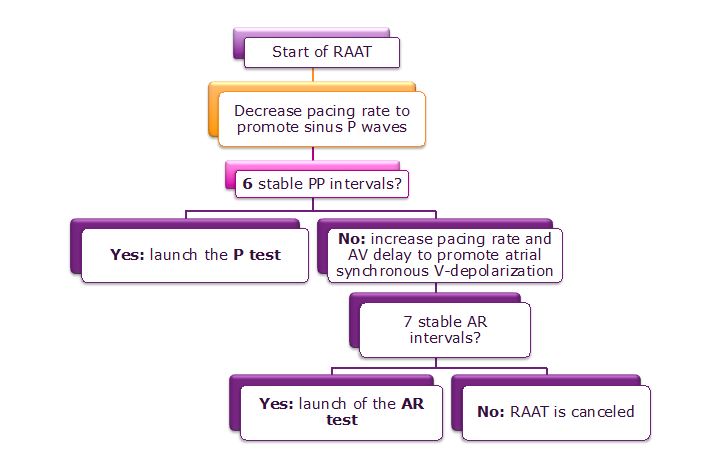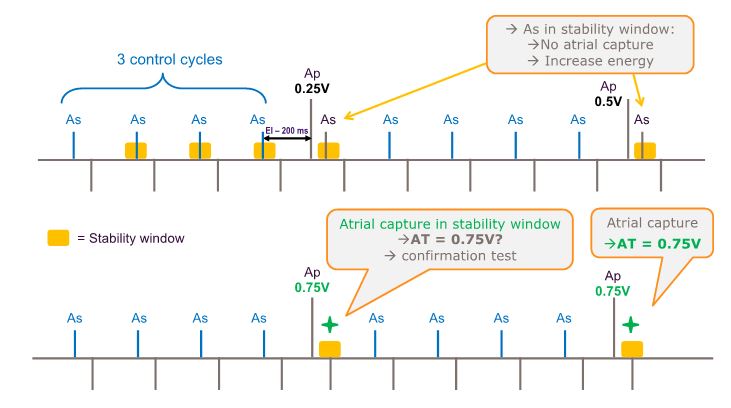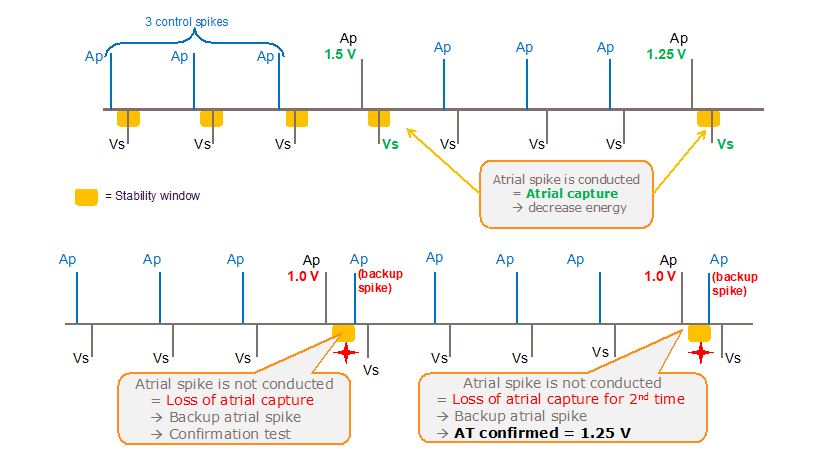Right Atrial Autothreshold (RAAT)
The device selects one of the following 2 methods, P test and AR test, to evaluate atrial capture based on the patient’s rhythm at the time of the pacing threshold search
- RAAT is launched every night at 1:00 am
- a selection phase is required to identify which test will be used
- P test runs during normal stable sinus rhythm; atrial threshold is measured by increasing the pacing voltage
- AR test runs when stable 1:1 AV conduction is observed with atrial pacing; atrial threshold is measured by decreasing the pacing voltage
P test
The P test is launched if the device has detected 6 PP intervals (7 P waves) over the last 8 cycles and the PP intervals are stable (<16 ms).
- overdriving of the atrial rate
- progressive increase of the atrial pacing amplitude (steps of 0.25 V)
- the diagnosis of atrial capture/non capture is based on the absence/presence of a sensed atrial signal following atrial pacing
- if there is one As after Ap: no atrial capture
- if there is no As after Ap: atrial capture
In order to check if the atrial spike is efficient (capture), the device calculates the PP stability window (PP average +/- 8 ms).
For each tested amplitude:
- the device senses 3 atrial signals that have to be within the stability window
- it delivers atrial pacing (spontaneous atrial rate – 200 ms to overdrive sinus rhythm)
- if an atrial signal is detected within the stability window: diagnosis of non capture and increase of the amplitude by 0.25 V steps
- if no atrial signal is detected within the stability window: diagnosis of capture; if a second capture occurs at the same amplitude, the test value corresponds to the atrial threshold
AR test
The device verifies the presence of a stable 1:1 AV conduction by prolonging the AV delay (450 ms) during 10 cycles (2 first cycles of transition).
- progressive decrease in the atrial pacing amplitude
- the diagnosis of atrial capture/non capture is based on the absence/presence of a sensed ventricular signal following atrial pacing
- if there is one R wave (Vs) after Ap: capture
- if there is no R wave (Vs) after Ap: no capture (atrial back-up pacing)
In order to check if the atrial spike is efficient (capture), the device calculates the Ap-Vs stability window (Ap-Vs average +/- 50 ms).
For each tested amplitude:
- decrease of the amplitude by 0.25 V steps
- the device delivers 3 control spikes (at 2 V or 5 V) + 1 test spike (tested amplitude)
- if a ventricular signal is detected within the stability window: capture
- if a ventricular signal is not detected within the stability window: non capture; atrial backup pacing at the end of the stability window; second test at the same amplitude; if non efficient: atrial threshold previous tested value
Adjustment of the amplitude
- the minimum atrial amplitude is programmable
- automatic adjustment of the atrial pacing amplitude: measured atrial threshold + 1 V
- if the measured threshold is > 3 V, the amplitude is automatically programmed to 5 V and RAAT is switched to OFF
- if RAAT cannot be measured, the device takes the same value as the day before
- if RAAT cannot be measured during more than 7 consecutive days, the atrial amplitude is programmed to the Safety atrial amplitude (programmable, nominal 3.5 V)
Programmable parameters
- RAAT: Auto, “Monitor”, Off
- minimum atrial amplitude: 1.0 – 5 – 2.0 – 2.5 V
- safety atrial amplitude: 2.5 – 5 – 4.0 – 5.0 V
- atrial autothreshold max rate: 75 – 80 – 85 – 90 – 95 – 100 – 110 min-1






